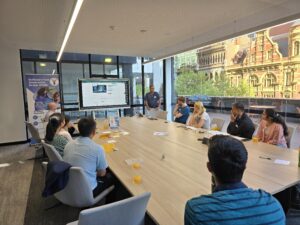
QA Leadership Challenge: Test Your Thinking!
June 30 @ 8:00 am - 5:00 pm UTC+0
🏆 Challenge:
Put on your QA strategy hat and step into a real-world scenario faced by many teams. The best response will receive a gift hamper and a shout-out during our next team session!

🏆 Winner Gets:
- A curated Gift Hamper
- Recognition in the next QA/Team Sync
- Optional shout-out on our next Meetups
Goal of the Exercise:
To assess your ability to handle real-world, time-sensitive QA scenarios where ambiguity is high, expectations are shifting, and the success of your contribution depends on both technical judgment and communication strategy.
⚠️ Scenario:
You’ve just joined a product team that has been building a platform for 2 years with no prior QA involvement.
- You’re told your main task is to “just write automation tests.”
- There are no clear acceptance criteria, no formal test cases, and the frontend developer just left the team.
- A go-live date is set for 8 weeks from now.
- Stakeholders are inconsistent—some expect lots of bugs, others want stable documentation.
- Legacy data issues are surfacing due to schema changes.
- No structured process exists for defect management or regression.
❓ Your Challenge:
Is it appropriate to expect the QA to focus only on Test automation in this scenario? Why or why not?
Please answer the following:
- Do you agree or disagree with the Test Automation-only focus?
- What would your phased QA strategy be for the first 4–6 weeks?
- How would you ensure test quality, team alignment, and visibility under pressure?
- What risks do you foresee if this is handled incorrectly?
📝 Instructions:
- Submit your response (1000–1500 words max)
- Use clear reasoning and real-world examples where possible
- Deadline: 30 Jun 2025
- Format: Markdown / Word / Email along with your name, small write-up about you.
- Send your responses to info@test-fast.com
✨ Evaluation Criteria:
- Depth of reasoning
- Realistic and structured QA approach
- Risk awareness
- Stakeholder communication awareness
- Originality
Think smart, test smarter — and win while doing it!
Let’s see who brings the most value-driven QA mindset to the table.
Follow-Up Challenge: Test Automation Expectation – Is That Enough?
Context:
In this scenario, the initial expectation set by the team was that the QA engineer’s role would be focused solely on creating automated tests for the platform’s UI.
Exercise Prompt:
Is it the right expectation to ask a QA to “just write Automated tests”?
- If YES – Justify:
Under what conditions could this be a valid and effective expectation? What assumptions must be true (e.g., maturity of requirements, stable application, existing manual coverage, etc.) for automation to be the primary focus from day one? - If NO – Explain Why:
Why is this expectation potentially shortsighted in a project that has never had QA before? What risks does it introduce? What key activities might be overlooked (e.g., requirement validation, test data planning, exploratory/manual testing, identifying critical bugs)? - What Should Be the Right Approach?
Based on the context (legacy data issues, schema drift, lack of traceability, inconsistent requirements), outline what a realistic QA strategy should look like in the first 4–6 weeks.
Consider:
- Manual validation vs automation
- Process setup (Zephyr, test documentation, traceability)
- Test prioritisation based on business risk
- Long-term value of reusable tests and metrics
Objective:
To evaluate whether automation is the right starting point, or just a component of a larger quality strategy—and to test your ability to challenge assumptions, reframe scope, and communicate the most value-driven QA approach for the business.
Complicating Factors:
- No formal acceptance criteria in stories or tasks
- No traceability between requirements and tests
- Unstable environments and limited access to test data
- Legacy records were failing due to schema drift and missing or invalid fields
- What should be expectations from stakeholders— a high number of defects to be raised, or creation of test maturity and documentation?
Scenario Exercise for Testers:
As the QA professional in this environment, how would you approach the following challenges?
Task Prioritisation:
With limited time and unclear expectations, what would you focus on first—manual test coverage, automation, environment setup, documentation, or defect logging?
Legacy Data Testing:
Many old records break due to past schema changes. What’s your test strategy for this? How do you ensure they’re validated without becoming blockers?
Visibility & Alignment:
How would you ensure your efforts are visible to the team and aligned with evolving expectations, especially in the absence of consistent feedback?
Defect Reporting Expectations:
How do you measure value in testing when requirements are not clearly defined? Would number of Defects Raised be right metrics?
Tool Selection & Justification:
Given the timeline and platform nature, how would you choose a testing tool (e.g., Playwright, Cypress, Selenium)? How would you balance setup time vs. future reusability?
Demonstrating Value in 8 Weeks:
What metrics, artifacts, or deliverables would you present at the end of your engagement to showcase impact—even if full test coverage isn’t yet achieved?
- Submit your response (1000–1500 words max)
- Use clear reasoning and real-world examples where possible
- Deadline: 30 Jun 2025
- Format: Markdown / Word / Email along with your name, small write-up about you.
- Send your responses to info@test-fast.com

